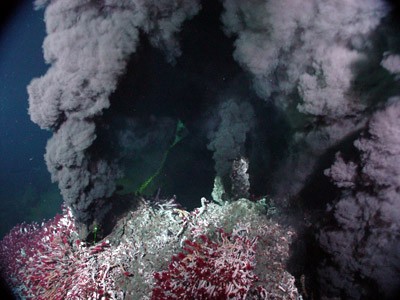Life on Earth Could Orginate from Deep Sea Hydrothermal Vents
| Ana Verayo | | Apr 29, 2015 07:12 AM EDT |
(Photo : Wikipedia) Hydrothermal vents found underwater can trigger life.
A new study details how organic molecules that spawned life on Earth, have arisen from hydrothermal vents on the seabed floor spontaneously.
Researchers and chemists from the University College London reveal that mineral particles found on the hydrothermal vents apparently possess properties that are similar to enzymes that are considered to be biological triggers that can control chemcial reactions in living organisms.
Like Us on Facebook
Hydrothermal vents are made from fissures or cracks from the surafce of the Earth that spew heated geothermal water. This is located in undersea volcanoes that are formed by converging tectonic plates.
These vents found on the ocean floor were first detected in 1977 in the Galapagos Islands as scientists were exloring ocean ridges says the National Oceanic and Atmospheric Administration (NOAA).
This extreme environment of hot, hydrothermal vents were thought to be one of the most inhospitable regions on Earth but scientists were surprised when they discovered living organisms in massive amounts thriving near the vents due to chemical reactions from the underwater volcanoes and the seawater.
Researchers from the University College London are now investigating how the first building blocks of life came to be on Earth that may have orginated from these hot, underwater environments of the hydrothermal vents.
According to study leader Nora de Leeuw of UCL, carbon dioxide was dissolved in the water that made the existence of the living organisms underwater possible including energy from the hot water. This new study proves that vents have chemical properties that encourage these molecules to combine with the molecules of living organisms.
Scientists conducted computer simuations with their laboratory results as they replicated hot, carbon dioxide rich, deep sea vent environments in order to investigate the processes how these mineral particles converted carbon dioxide into organic molecules.
According to co-author of the study Nathan Hollingworth, the mineral surfaces and crystal structures inside these vents apparently act as catalysts that trigger chemical changes. They behave like enzymes in living organisms where they combine with water.
This study is published in the journal Chemical Communications.
Tagshydrothermal vents, first living organisms on Earth, hot vents seafloor living organisms, origin of life hot vents seafloor
©2015 Chinatopix All rights reserved. Do not reproduce without permission
EDITOR'S PICKS
-

Did the Trump administration just announce plans for a trade war with ‘hostile’ China and Russia?
-

US Senate passes Taiwan travel bill slammed by China
-

As Yan Sihong’s family grieves, here are other Chinese students who went missing abroad. Some have never been found
-

Beijing blasts Western critics who ‘smear China’ with the term sharp power
-

China Envoy Seeks to Defuse Tensions With U.S. as a Trade War Brews
-

Singapore's Deputy PM Provides Bitcoin Vote of Confidence Amid China's Blanket Bans
-

China warns investors over risks in overseas virtual currency trading
-

Chinese government most trustworthy: survey
-

Kashima Antlers On Course For Back-To-Back Titles
MOST POPULAR
LATEST NEWS
Zhou Yongkang: China's Former Security Chief Sentenced to Life in Prison

China's former Chief of the Ministry of Public Security, Zhou Yongkang, has been given a life sentence after he was found guilty of abusing his office, bribery and deliberately ... Full Article
TRENDING STORY

China Pork Prices Expected to Stabilize As The Supplies Recover

Elephone P9000 Smartphone is now on Sale on Amazon India

There's a Big Chance Cliffhangers Won't Still Be Resolved When Grey's Anatomy Season 13 Returns

Supreme Court Ruled on Samsung vs Apple Dispute for Patent Infringement

Microsoft Surface Pro 5 Rumors and Release Date: What is the Latest?










